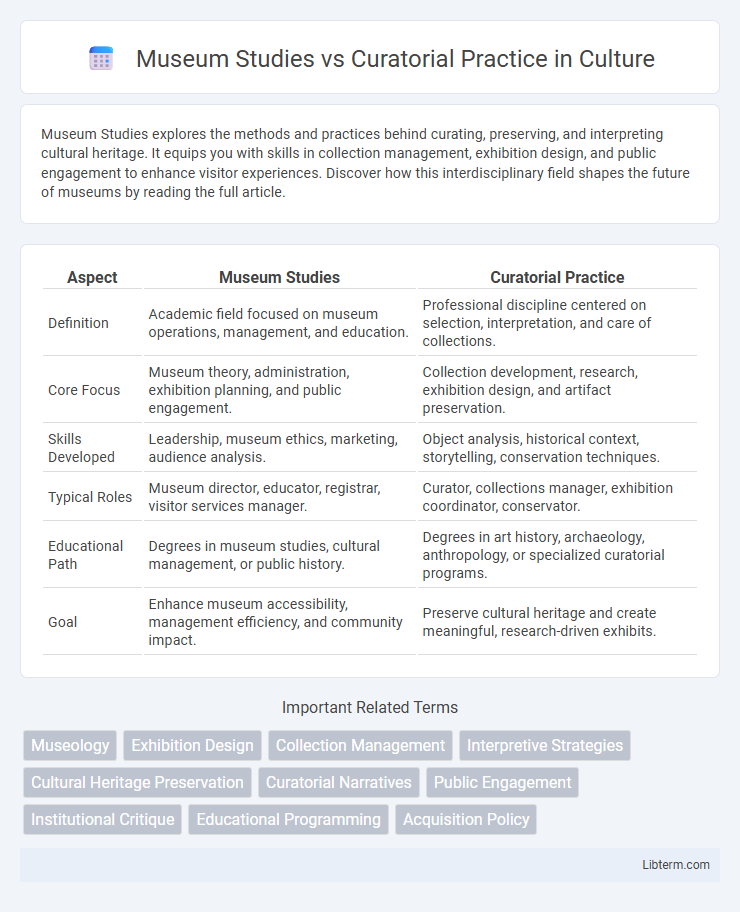Museum Studies explores the methods and practices behind curating, preserving, and interpreting cultural heritage. It equips you with skills in collection management, exhibition design, and public engagement to enhance visitor experiences. Discover how this interdisciplinary field shapes the future of museums by reading the full article.
Table of Comparison
| Aspect | Museum Studies | Curatorial Practice |
|---|---|---|
| Definition | Academic field focused on museum operations, management, and education. | Professional discipline centered on selection, interpretation, and care of collections. |
| Core Focus | Museum theory, administration, exhibition planning, and public engagement. | Collection development, research, exhibition design, and artifact preservation. |
| Skills Developed | Leadership, museum ethics, marketing, audience analysis. | Object analysis, historical context, storytelling, conservation techniques. |
| Typical Roles | Museum director, educator, registrar, visitor services manager. | Curator, collections manager, exhibition coordinator, conservator. |
| Educational Path | Degrees in museum studies, cultural management, or public history. | Degrees in art history, archaeology, anthropology, or specialized curatorial programs. |
| Goal | Enhance museum accessibility, management efficiency, and community impact. | Preserve cultural heritage and create meaningful, research-driven exhibits. |
Introduction to Museum Studies and Curatorial Practice
Introduction to Museum Studies emphasizes the theoretical frameworks and historical development of museums, exploring their cultural roles, management, and educational functions. In contrast, Introduction to Curatorial Practice focuses on hands-on skills such as collection management, exhibition planning, and interpretive strategies. Both fields intersect through their commitment to preserving cultural heritage while enhancing public engagement and knowledge dissemination.
Defining Museum Studies: Scope and Focus
Museum Studies encompasses a multidisciplinary approach to understanding museums' roles, management, education, and cultural significance, emphasizing theoretical frameworks and research methodologies. Its scope extends beyond exhibition design to include museum administration, audience engagement, conservation, and community outreach. Curatorial Practice, a subset within this field, concentrates specifically on artifact acquisition, interpretation, and exhibition development, highlighting the hands-on, interpretive aspects of museum work.
Understanding Curatorial Practice: Key Elements
Curatorial practice encompasses the critical elements of exhibition planning, collection management, and audience engagement, which are essential for effective museum operations. It involves the strategic selection, interpretation, and presentation of artifacts to communicate meaningful narratives, often requiring collaboration between curators, conservators, and educators. Knowledge of these key components enhances the ability to create dynamic, educational, and contextually relevant exhibitions within the broader field of museum studies.
Educational Pathways: Museum Studies vs Curatorial Practice
Museum Studies programs typically offer broad interdisciplinary curricula covering collection management, exhibition design, and museum education, preparing students for diverse roles in museums. Curatorial Practice focuses more narrowly on art history, object analysis, and research methodologies, emphasizing the development of expertise essential for curators. Educational pathways in Museum Studies usually include internships and hands-on experience across various museum departments, whereas Curatorial Practice often involves specialized mentorship and advanced study in specific subject areas.
Core Skills Developed in Each Field
Museum Studies develops core skills in collections management, exhibition planning, and museum education, emphasizing analytical research and public engagement. Curatorial Practice focuses on expertise in acquisition, art interpretation, and hands-on object care, highlighting creative curation and detailed provenance research. Both fields require strong communication, critical thinking, and a deep understanding of cultural heritage.
Career Opportunities in Museums and Galleries
Museum Studies programs offer a broad foundation in museum operations, collections management, and educational programming, preparing graduates for diverse roles such as museum educators, archivists, and exhibition coordinators. Curatorial Practice focuses specifically on the development, research, and management of exhibitions, equipping professionals for careers as curators, art historians, and collection specialists within galleries and museums. Both fields provide valuable pathways to careers that involve preserving cultural heritage, promoting public engagement, and contributing to the strategic vision of museums and galleries worldwide.
Overlapping Roles and Interdisciplinary Connections
Museum Studies and Curatorial Practice share overlapping roles in collection management, exhibition design, and audience engagement, highlighting the essential interdisciplinary connections between museum education, art history, and cultural preservation. Both fields require a deep understanding of object interpretation, ethical stewardship, and museum administration, fostering collaboration among professionals with expertise in conservation, research, and public programming. This synergy supports the holistic development of museum strategies that balance scholarly rigor with visitor experience.
Academic Curriculum Comparison
Museum Studies programs emphasize comprehensive interdisciplinary courses including museum management, conservation, education, and public engagement, preparing students for diverse roles within the museum sector. Curatorial Practice curricula focus intensely on art history, exhibition design, collection development, and research methodologies to cultivate expertise in managing and interpreting collections. Academic programs in Museum Studies often offer broader theoretical and practical training, while Curatorial Practice centers on specialized skills essential for curatorship and exhibition leadership.
Professional Challenges and Future Trends
Museum Studies emphasizes theoretical knowledge and broad museum management skills, while Curatorial Practice centers on the hands-on development and interpretation of collections. Professional challenges include adapting to technological advancements, addressing inclusivity and diversity in exhibits, and securing sustainable funding. Future trends highlight the integration of digital curation, interactive visitor experiences, and increased collaboration between museums and communities.
Choosing the Right Path: Factors to Consider
Choosing the right path between Museum Studies and Curatorial Practice depends on your career goals, skill set, and interests in collection management versus exhibition design. Consider factors such as whether you prefer the administrative and educational aspects of museum operations or the creative and research-based responsibilities of curating. Analyzing program curriculum, internship opportunities, and job placement rates can also help align your academic choice with long-term professional objectives.
Museum Studies Infographic

 libterm.com
libterm.com